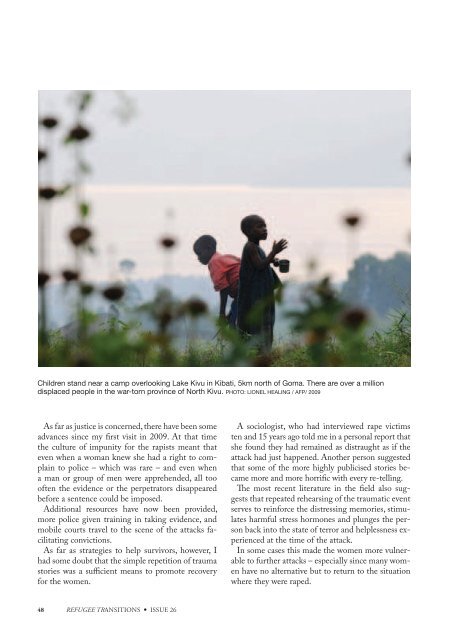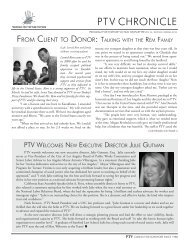Interview with Dr. Jose Quiroga, Page 19 - Program for Torture Victims
Interview with Dr. Jose Quiroga, Page 19 - Program for Torture Victims
Interview with Dr. Jose Quiroga, Page 19 - Program for Torture Victims
Create successful ePaper yourself
Turn your PDF publications into a flip-book with our unique Google optimized e-Paper software.
“The model uses the tree and its component parts as a way <strong>for</strong> children to<br />
think about their lives: their roots, their strengths, their aspirations and the<br />
people who knew and had supported them in the past. The idea is that by<br />
identifying these positives, they are more likely to look at the difficulties they<br />
experience from a place of strength and safety and focus on the future rather<br />
than the past.”<br />
Children stand near a camp overlooking Lake Kivu in Kibati, 5km north of Goma. There are over a million<br />
displaced people in the war-torn province of North Kivu. PHOTO: LIONEL HEALING / AFP/ 2009<br />
As far as justice is concerned, there have been some<br />
advances since my first visit in 2009. At that time<br />
the culture of impunity <strong>for</strong> the rapists meant that<br />
even when a woman knew she had a right to complain<br />
to police – which was rare – and even when<br />
a man or group of men were apprehended, all too<br />
often the evidence or the perpetrators disappeared<br />
be<strong>for</strong>e a sentence could be imposed.<br />
Additional resources have now been provided,<br />
more police given training in taking evidence, and<br />
mobile courts travel to the scene of the attacks facilitating<br />
convictions.<br />
As far as strategies to help survivors, however, I<br />
had some doubt that the simple repetition of trauma<br />
stories was a sufficient means to promote recovery<br />
<strong>for</strong> the women.<br />
A sociologist, who had interviewed rape victims<br />
ten and 15 years ago told me in a personal report that<br />
she found they had remained as distraught as if the<br />
attack had just happened. Another person suggested<br />
that some of the more highly publicised stories became<br />
more and more horrific <strong>with</strong> every re-telling.<br />
The most recent literature in the field also suggests<br />
that repeated rehearsing of the traumatic event<br />
serves to rein<strong>for</strong>ce the distressing memories, stimulates<br />
harmful stress hormones and plunges the person<br />
back into the state of terror and helplessness experienced<br />
at the time of the attack.<br />
In some cases this made the women more vulnerable<br />
to further attacks – especially since many women<br />
have no alternative but to return to the situation<br />
where they were raped.<br />
In this case, what they need are strategies to keep<br />
themselves safe, and groups of survivors can help<br />
each other by sharing in<strong>for</strong>mation of this nature.<br />
It may also be that due to the overwhelming emotions<br />
and confusion at the time of the attack that<br />
some women have confused memories of what actually<br />
took place. And hearing what happened to other<br />
women can even create false memories of their<br />
own experience.<br />
Whether or not this is true, in subsequent workshops,<br />
in 2010, I suggested a model of work that<br />
moved on from re-telling the traumas, and I asked<br />
counsellors to assess its usefulness in their work.<br />
This model, a Brief Intervention <strong>for</strong> Trauma<br />
Symptoms (BITS), was developed by <strong>Dr</strong> Steve<br />
Stathis, a psychiatrist based in Brisbane. Briefly,<br />
it suggests four aspects of treatment.<br />
The first one is to provide in<strong>for</strong>mation about the<br />
complex consequences of trauma which will help<br />
the person understand that their reactions are normal<br />
given what they have experienced – this is a<br />
<strong>for</strong>m of psycho-education.<br />
A second is to allow a person to express what has<br />
happened to them and, most importantly, identify<br />
specific symptoms that are affecting their daily<br />
functioning – a brief trauma narrative. Of course,<br />
this is also essential <strong>for</strong> the counsellor’s understanding<br />
of the person’s needs.<br />
The third aspect of the model involves cognitive<br />
restructuring to help the person move from selfblame<br />
and shame to be able to place the blame on<br />
the perpetrator. I was able to link this <strong>with</strong> the hospital’s<br />
Women Stand-Up Together program. It involves<br />
a number of centres throughout the province,<br />
where women gather <strong>for</strong> training about their rights<br />
and also to learn skills in sewing, small-animal husbandry<br />
and agriculture.<br />
The fourth aspect consists of symptom management<br />
where the person is assisted to identify the<br />
personal strengths that have allowed them to survive<br />
and then build on these to recover. The model<br />
was very positively evaluated by the 11 members of<br />
the counselling staff who attended the workshop.<br />
Un<strong>for</strong>tunately, it is difficult to know the extent to<br />
which they are implementing it in their work, or are<br />
training others to use it.<br />
A second series of workshops was given on my visit<br />
in 2010, which I called “Protect the Little Children”,<br />
in which 26 staff members, who work <strong>with</strong> children<br />
in the hospital’s community health programs and<br />
programs <strong>for</strong> families living <strong>with</strong> HIV, participated.<br />
In 2009, I had learnt that while children suffer<br />
sexual assault and incest, as well as war-trauma, their<br />
needs were often overlooked. I introduced the usual<br />
experiential exercises to enhance communication<br />
skills and elicit the types of issues the participants<br />
were facing in their work.<br />
I also gave mini-lectures on child development, explored<br />
the nature of traumatic events, and of the lifechanging<br />
impact of such events on a child’s physical<br />
health, their ability to learn, to handle their emotions<br />
and <strong>for</strong>m relationships throughout life. This material<br />
was new to the participants and highly valued. The<br />
issues raised prompted me to plan a special “train the<br />
trainers” workshop <strong>for</strong> my visit in 2011.<br />
For this workshop I chose four staff members<br />
from different programs at the hospital – a program<br />
coordinator, a nurse-psychologist, a counsellor, and<br />
a chaplain – to explore the Tree of Life model <strong>for</strong><br />
severely traumatised children. I knew them all well<br />
from previous workshops and had seen their commitment<br />
and capacity in action.<br />
The model uses the tree and its component parts<br />
as a way <strong>for</strong> children to think about their lives:<br />
their roots, their strengths, their aspirations and<br />
the people who knew and had supported them in<br />
the past.<br />
The idea is that by identifying these positives,<br />
they are more likely to look at the difficulties they<br />
experience from a place of strength and safety and<br />
48<br />
REFUGEE TRANSITIONS • ISSUE 26 HEAL AFRICA 49




